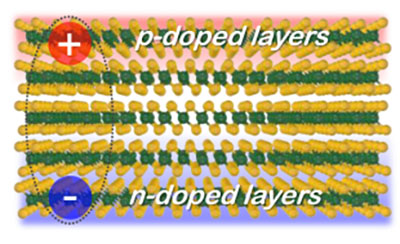| Dec 20, 2023 |
Room temperature quasiparticle discovery advances superconductivity research
(Nanowerk News) Searching for superconductors – materials with zero resistivity – with the critical temperature approaching room temperature is one of the holy grails of science, with massive potential for transforming fundamental science, applied science, and society.
|
|
Researchers at the Technical University of Denmark discovered that single WSe2 crystals exhibit clear signatures of correlated tunnelling of excitons, a precursor for exciton superfluidity – and supercurrents – at room temperature. This could pave the way for the development of room-temperature devices with superconductivity-like behavior.
|
 |
| Exciton formation in multilayer WSe2 crystal. (Image courtesy of the researchers)
|
|
Excitons, fundamental in this research, are quasiparticles formed when an electron in a semiconductor binds to a positively charged 'hole'. These excitons can condense into a collective quantum state, akin to the Cooper pairs in superconductors, a phenomenon known as Bose-Einstein condensation. This condensation has long been explored as a potential route to high-temperature superconductivity.
|
|
Historically, observing exciton condensates was feasible only under extremely low temperatures and high magnetic fields due to their low binding energy and short lifetime. The advent of van der Waals (vdW) heterostructures, which consist of two-dimensional (2D) layered materials stacked on top of each other, however, changed the landscape. These structures enable the preservation of various quantum phenomena, including exciton condensates, even at room temperature due to their weak screening and strong Coulomb interactions.
|
|
Previously, achieving exciton superfluids was thought to require a complex stack of at least three different crystals. Technically, fabrication of very clean interfaces structure with precisely aligned 2D crystals is challenging, even for the experienced experts in 2D labs. Defects, contamination, interlayer mismatch, and other stacking imperfections in the vdW heterostructures interfere with the interactions between the electron and hole-carrier layers, resulting in reduced the exciton binding energy and lifetime.
|
|
The Danish research team's innovation lies in demonstrating correlated electron-hole pair tunneling in a monolithic multilayer WSe2 device with bottom gold (Au) contacts. This device, featuring a naturally formed vertical homojunction within the vdW crystal, provides a defect-free interface crucial for observing correlated tunneling at room temperature. Significantly, the team observed zero-bias peaks in differential conductance curves, indicative of electron-hole pairing - a key feature for exciton formation and superfluidity.
|
|
Manh-Ha Doan, the lead researcher, is optimistic about the implications of this investigation, remarked on the potential ease of realizing high-temperature exciton condensates, emphasizing the ongoing efforts towards a room temperature superfluid device. "Many groups are trying to realize exciton condensates at high temperatures. We show that it is not only possible, but it may be even easy" he said.
|
|
Professor Peter Bøggild, who is the leader of the NANOMADE section at the Technical University of Denmark, shares this excitement, acknowledging the significant interest this research has generated. “We have received quite a lot of interest for this. We do not know with certainty that the devices are really what they appear to be. If these findings are confirmed, it could herald a new era of technology that operates on quantum principles at ambient temperatures” he added.
|
|
This research was conducted in the Department of Physics Department at the Technical University of Denmark and received support from the Graphene Flagship and the Villum Foundation. The main results were recently published in the journal of Applied Physics Letters ("Signature of correlated electron–hole pair tunneling in multilayer WSe2 at room temperature").
|

